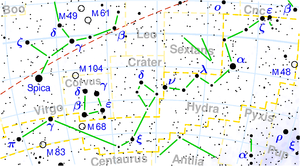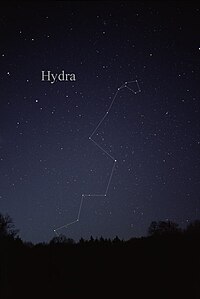Water snake (constellation)
|
Constellation Water Snake |
|
|---|---|
| Latin name | Hydra |
| Latin genitive | Hydrae |
| Abbreviation | Hya |
| Right ascension | 08 h 10 m 56 s to 15 h 02 m 31 s |
| declination | −35 ° 41 ′ 46 ″ to + 6 ° 37 ′ 49 ″ |
| surface | 1302.844 deg² rank 1 |
| Completely visible | 53.0 ° N to 83.8 ° S |
| Observation time for Central Europe | spring |
| Number of stars brighter than 3 mag | 2 |
| Brightest star (size) | Alphard (1.98) |
| Meteor streams | |
|
Neighboring constellations ( clockwise from north ) |
|
| swell | IAU , |
The water snake ( Latin / technical language Hydra ) is a constellation south of the celestial equator .
description
The water snake is the largest constellation in the night sky. It extends below the constellations Cancer (Cancer), Leo (Leo) and Virgin (Virgo) and can be observed from our part of the spring low on the southern horizon.
The water snake is not very prominent because most of its stars are faint. Only the main star Alphard is strikingly bright at 1.98 m .
history
The "female" or large water snake is one of the constellations of ancient Greek astronomy that were already described by Ptolemy .
In the 16th century the "male", southern or small water snake (lat. Hydrus) was introduced. However, this constellation is so far south that it cannot be observed from Europe.
mythology
There are two versions of the mythological origin:
According to the first, the water snake represents the many-headed monster Hydra that plagued the swamps around the town of Lerna . The hero Heracles was given the task of killing the beast. But Heracles found that for every head that the Hydra cut off with the sword, two new ones grew. At the same time he was attacked by a giant cancer. Heracles succeeded in crushing the crab, but he could only defeat the hydra with the help of his nephew Iolaos . He had brought firewood and every time Heracles had cut off a head of the monster, he burned out the wound so that no more heads could grow back.
The Hydra, Cancer and Heracles (Hercules) were immortalized as constellations in the sky.
Another version connects the water snake with the neighboring constellations Raven (Corvus) and Becher (Crater). Accordingly, the god Apollo sent a raven to fetch fresh spring water for Zeus . The raven grabbed a gold goblet and flew to the spring. On the way he discovered a fig tree, the fruits of which, however, were still immature. Although Apollo had instructed him not to waste any time, the raven waited several days for the fruit to ripen and then feasted on it. To avoid punishment, he grabbed a water snake and flew it to Apollo, claiming that the snake had blocked his way so that he could only return now. Apollo saw through the liar and, as a warning, sent him together with the snake and the cup to the sky.
Celestial objects
Stars
| B. | F. | Names or other designations |
Apparent size (mag) |
Del. ( Ly ) |
Spectral class |
|---|---|---|---|---|---|
| α | 30th | Alphard | 1.98 | 177 | K3 III |
| γ | 46 | 2.99 | G6 III | ||
| ζ | 16 | 3.11 | 151 | K0 III | |
| ν | 3.11 | 139 | K2 III | ||
| π | 46 | 3.25 | 101 | ||
| ε | 11 | 3.38 | 135 | G0 + F7 | |
| R Hydri | 3.5 to 10.9 | M7 III | |||
| ξ | 3.54 | 129 | G7 III | ||
| λ | 41 | 3.61 | 115 | K0 III | |
| μ | 42 | 3.83 | 249 | K4 III | |
| θ | 22nd | 3.89 | 129 | A0 V | |
| ι | 35 | 3.90 | 276 | K3 III | |
| C. | 3.91 | A0 V | |||
| υ 1 | 39 | 4.11 | G8 III | ||
| δ | 4th | 4.14 | 179 | A0 V | |
| β | 4.29 | 367 | B9 III | ||
| η | 7th | 4.30 | 466 | B3 V | |
| D. | 12 | 4.32 | |||
| ρ | 13 | 4.35 | 336 | A0 V | |
| E. | 58 | 4.42 | |||
| σ | 5 | Minchir , Michar | 4.45 | 355 | K1 III |
| τ | 31 | Ukdah | 4.59 | F6 + K2 | |
| υ 2 | 40 | 4.60 | |||
| F. | 4.63 | ||||
| ο | 4.70 | ||||
| P | 27 | 4.7 | G8 + F2 | ||
| 4.7 to 5.2 | C6 II | ||||
| G | 4.72 | ||||
| I. | 4.76 | ||||
| 26th | 4.77 | ||||
| k | 51 | 4.78 | 518 | ||
| 9 | 4.87 | ||||
| φ | 4.91 | ||||
| χ 1 | 4.92 | ||||
| ψ | 45 | 4.94 | 231 | ||
| l | 52 | 4.97 | |||
| a | 6th | 4.98 | |||
| ω | 18th | 4.99 | 1208 | ||
| N | 5.0 | F8 + F8 | |||
| 50 | 5.07 | ||||
| 44 | 5.08 | ||||
| m | 54 | 5.15 | |||
| 47 | 5.20 | ||||
| b 3 | 5.23 | ||||
| 56 | 5.23 | ||||
| 23 | 5.24 | ||||
| 14th | 5.30 | ||||
| b 1 | 5.44 | ||||
| 20th | 5.47 | ||||
| 24 | 5.49 |
Alpha Hydrae is an orange shining star of the spectral class K3 at a distance of 177 light years .
The name Alphard is derived from the Arabic al farad , which means something like "the single person". Another name is Cor Hydrae , "heart of the water snake".
Double stars
| system | Sizes (mag) | distance |
|---|---|---|
| ε | 3.4 / 7.0 | 2.7 " |
| τ 1 | 4.6 / 7.6 | 66 " |
| 27 | 4.8 / 7.0 / 9.0 | 230 "/ 9.6" |
| N | 5.6 / 5.8 | 9.2 " |
Epsilon Hydrae is a binary star system 100 light years away. To resolve it into single stars you need a telescope with an opening of 8 cm or more.
Tau Hydrae appears as a double star in prism binoculars . In fact, it is an "optical" double star, the components of which are not connected by gravity , but only lie in one direction when viewed from Earth
27 Hydrae is a multiple star system in which three stars revolve around a common center of gravity. All three components are already visible in a small telescope with an opening of 6 cm or more.
Variable stars
| star | Apparent Size (mag) | period | Type |
|---|---|---|---|
| R. | 3.5 to 10.9 | 387 days | Mira star |
| U | 4.7 to 6.2 | 450 days | semi-regular |
| V | 6.5 to 12.5 | Mira star |
R Hydrae is a pulsation-variable Mira- type star 500 light years away. At the maximum it reaches a brightness of 3.5 m , at the minimum it drops to a brightness of 10.9 m . The brightness varies with a period of around 387 days. Records have shown that the period in the 18th century was much longer at around 500 days.
U Hydrae is a star 2000 light years away, the brightness of which changes with a period of about 450 days. At its maximum, it reaches a brightness of 4.7 m and can be seen with the naked eye. At a minimum, its brightness drops to 6.2 m , so that binoculars are required to observe it. During the minimum it is noticeably reddish.
V Hydrae is a deep red star of the Mira type. Its brightness varies between 6.5 m and 12.5 m .
Messier and NGC objects
| Messier (M) | NGC | other | Size (mag) | Type | Surname |
|---|---|---|---|---|---|
| 48 | 2548 | 5.5 | Open star cluster | ||
| 68 | 4590 | 8.5 | Globular clusters | ||
| 83 | 5236 | 8th | Galaxy | ||
| 3109 | 9.9 | Galaxy | |||
| 3242 | 9 | Planetary nebula | Jupiter's spirit | ||
| 3314 | 14th | Galaxy | |||
| 3621 | 9.9 | Galaxy | |||
| 5694 | 10 | Globular clusters |
M 48 is an open star cluster 2500 light years away, which is a worthwhile sight even in binoculars.
M 68 is a globular cluster 30,000 light years away . It can only be resolved into single stars with a larger telescope.
M 83 is a Sc-type spiral galaxy about 15 million light years away. It can already be seen in the binoculars as a misty spot. In the larger telescope, a bright core and approaches of spiral arms can be seen. It is not easy to observe from Germany because it is low above the horizon and the denser layers of air obstruct the view.
NGC 3242 is a planetary nebula 3000 light years away. At high magnification it is visible as a greenish disc in the telescope. Since its apparent diameter in the sky roughly corresponds to that of the planet Jupiter , it is also called Jupiter's spirit .
NGC 3314 are two interacting galaxies 140 million light years away.

